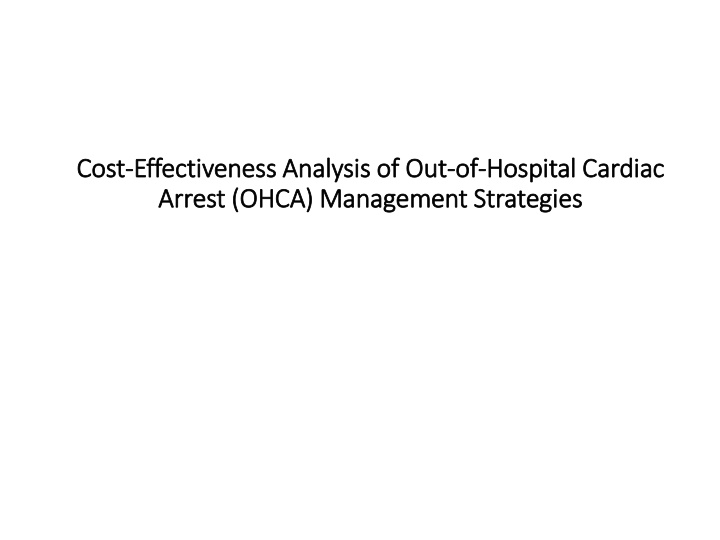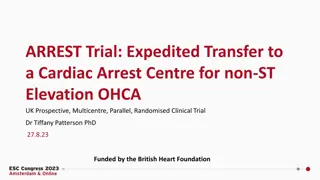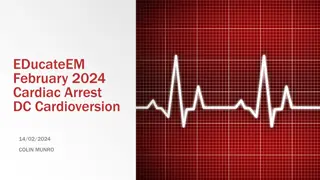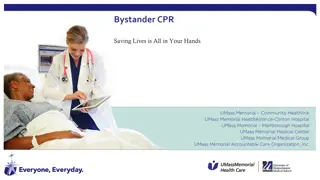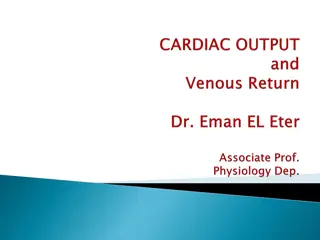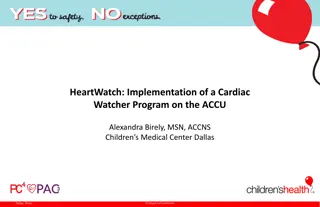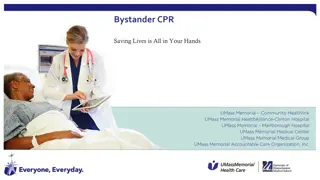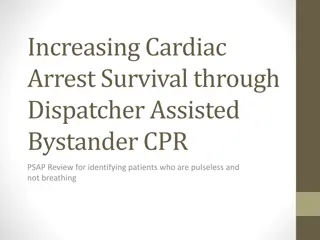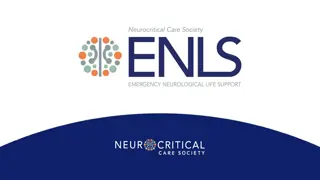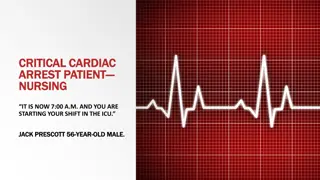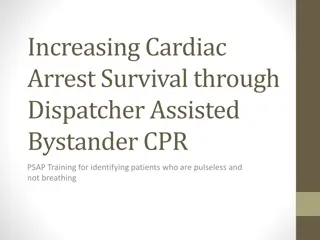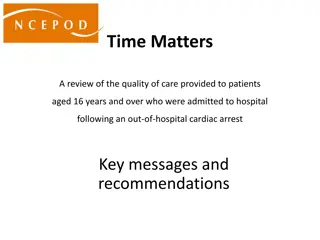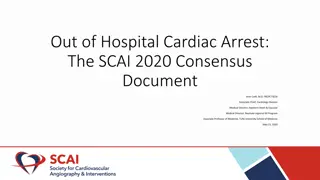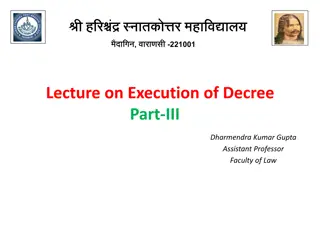Cost-Effectiveness Analysis of Out-of-Hospital Cardiac Arrest Management Strategies
Out-of-hospital cardiac arrest (OHCA) poses a significant health challenge with a low survival rate. This study evaluates the cost-effectiveness of immediate angiography and PCI compared to standard care for OHCA patients. Decision tree modeling and sensitivity analyses were used to assess the economic and health outcomes over a one-year horizon. Key parameters such as probability values, intervention costs, and quality adjusted life-years were considered. The findings aim to inform healthcare decision-making in OHCA management strategies.
Download Presentation

Please find below an Image/Link to download the presentation.
The content on the website is provided AS IS for your information and personal use only. It may not be sold, licensed, or shared on other websites without obtaining consent from the author.If you encounter any issues during the download, it is possible that the publisher has removed the file from their server.
You are allowed to download the files provided on this website for personal or commercial use, subject to the condition that they are used lawfully. All files are the property of their respective owners.
The content on the website is provided AS IS for your information and personal use only. It may not be sold, licensed, or shared on other websites without obtaining consent from the author.
E N D
Presentation Transcript
Cost Cost- -Effectiveness Analysis of Out Effectiveness Analysis of Out- -of of- -Hospital Cardiac Arrest (OHCA) Management Strategies Arrest (OHCA) Management Strategies Hospital Cardiac
Introduction Out-of-hospital cardiac arrest (OHCA) is the sudden cessation of the heart in an out of hospital setting. In the United States, the incidence of OHCA is estimated at 110 individuals per 100,000 . The overall survival rate is 10.8%. The American Heart Association (AHA) guidelines recommends angiography for patients who have ST elevation in electrocardiogram followed by proper treatments. In patients without ST elevation, other general test and observations would be conducted before further interventions. Some evidence suggests that angiography and immediate percutaneous intervention for OHCA patients could result in better healthcare outcomes regardless of the presence of ST elevation in electrocardiogram. The goal of this study is to investigate whether immediate angiography and PCI are cost-effective compared to the standard of care. It is important to state the time duration.
Methods We built a decision tree model in TreeAge Pro to compare the cost-effectiveness of immediate angiography followed by proper interventions to standard care. The model calculates the costs and benefits of each strategy over a one-year time- horizon. We reviewed the literatures to obtain the model parameters, including the outcome probabilities, intervention costs, quality of life weights and life expectancy estimates. We calculated the incremental cost-effectiveness ratio of immediate angiography strategy compared to standard of care. In addition, we calculated the robustness of our outcomes using one-way sensitivity analysis, and probabilistic sensitivity analysis (PSA) were varied all the parameters jointly.
Base case estimates and ranges Base Case Estimate Range Reference or Source Notes Probability values Sensitivity of EKG Larger than 70% stenosis Larger than 70% stenosis conditional on true positive EKG result Larger than 70% stenosis conditional on false negative EKG result PCI succeed All are following Beta distribution (3) (15) (2) 0.88 0.66 0.96 0.74-0.96 0.561-0.759* 0.816-1.000* = 36.3; =4.95 =58.58; =30.18 =6.15; =0.256 0.58 0.493-0.667* (2) =74.09; =53.65 0.74 0.629-0.851* (2) =45.48; =15.98 Cost ($) Procedures of PCI Procedures of CABG Procedures of medical treatment in immediate action Procedures of medical treatment in delayed action All are following Log normal distribution (8) (8) (9) 35,991 39,581 37,478** 18,842-53,140 25,828-53,334 31,856-43,100* =10.46; =0.235 =10.57; =0.173 =10.53; =0.075 38,154** 32,431-43,877* (10) =10.55; =0.075 Quality adjusted life-years (QALY) PCI procedures in immediate action CABG procedures in immediate action All are following Beta distribution (3) (3) 0.82 0.80 0.63-1.00 0.64-0.96 =12.59; =2.76 =19.2; =4.8 Medical treatments PCI procedures in delayed action CABG procedures in delayed action 0.911 0.700 0.643 0.77-1.00* 0.595-0.805* 0.547-0.740* (7) (6) (6) =13.95; =1.36 =52.63; =22.56 =63.42; =35.21 The base case value means the best estimate for each variables. Unless otherwise noted, ranges are defined by 95% confidence intervals. * The range are estimated from 85% to 115% ** The values are from the calculation of inflation estimate from the study
Analysis For both treatment strategies, our model calculated quality adjusted life years and costs in 1-year time horizon. We compared the performance of the two treatment strategies through the incremental cost-effectiveness ratio (ICER), defined as marginal cost divided by the marginal effectiveness. We conducted one-way sensitivity analyses for every variable in our model to assess the influences of them within a clinically plausible range on cost-effectiveness. And we plotted the Tornado diagrams for probability, cost and effectiveness. Additionally, we conducted Probabilistic sensitivity analysis (PSA) through Monte Carlo simulation. We thought probabilities and quality adjusted life-years are following Beta distribution and the cost of interventions are following Log-normal distribution.
Results Immediate angiography was more expensive than the standard care ($122) per patient treated, but more effective [0.03 quality-adjusted life-years (QALYs)], resulting in an ICER of $3600/QALY compared to the standard care. These findings were robust to all one-way sensitivity analyses. In addition, the PSA showed that there is more than 80% probability that immediate angiography is more cost effective than the standard care conditional on $100,000/QALY willingness to pay threshold. Incremental Cost Effectiveness Ratio (ICER) Strategy Cost Incr Cost Eff Incr eff IncrC/E (ICER) NMB C/E Standard care 36951.73 0.81 3748.93 45394.51 Immediate Angiography 37073.55 121.83 0.85 0.03 3637.16 5301.85 43744.19
One One- -way sensitivity analysis (Tornado Diagram) way sensitivity analysis (Tornado Diagram)
Probabilistic Sensitivity Analysis C4 C2 C6 C3 C1 C5 Component Quadrant Incr Eff Incr Cost Incr CE Frequency Proportion C1 IV IE>0 IC<0 Superior 4097 0.4097 C2 I IE>0 IC>0 ICER<100,000 4366 0.4366 C3 III IE<0 IC<0 ICER>100,000 188 0.0188 C4 I IE>0 IC>0 ICER>100,000 706 0.0706 C5 III IE<0 IC<0 ICER<100,000 205 0.0205 C6 II IE<0 IC>0 inferior 438 0.0438
The acceptability curve shows the probability of being cost-effective under different threshold of willingness to pay.
Conclusion Our results suggest that immediate angiography is more cost effective than the standard care for OHCA patients from a societal perspective because the ICER is well below the upper limit of the threshold that is generally considered to be cost-effective by many health-care agencies.
Future Future Micro-Cost Analysis Update latest data Modifying treatment guidelines Reallocating healthcare resources
